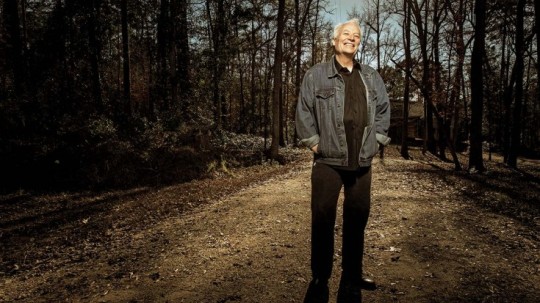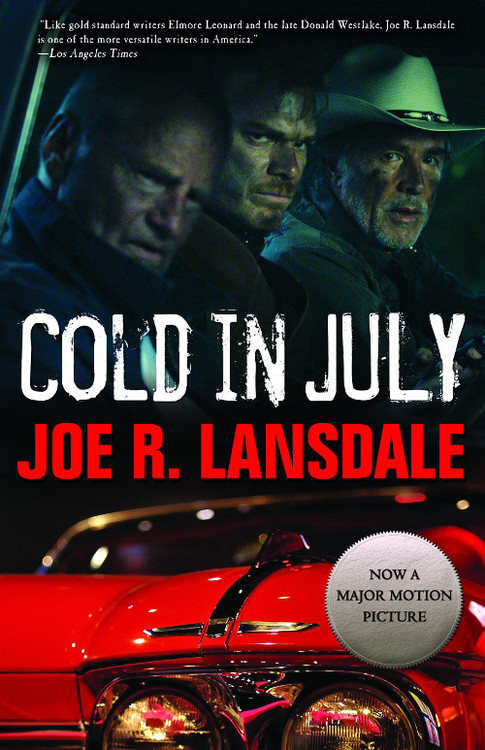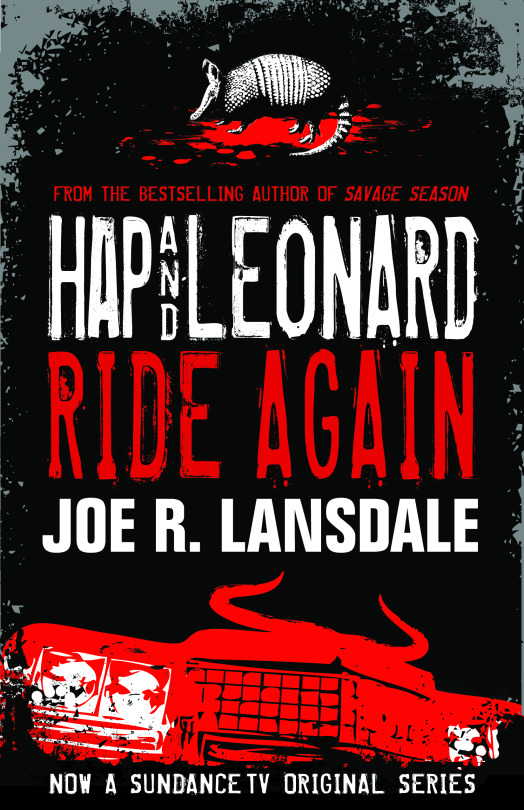For a hell of a nice guy, Joe R. Lansdale surely plumbs the darkness

Photograph by LeAnn Mueller
Eric Benson for TEXAS MONTHLY delivered a lengthy and fascinating profile of the prolific Lansdale.
Joe R. Lansdale—author of more than 45 novels and 400 short stories, essays, comic books, and screenplays, ranging in genre from historical fiction to grind-house pulp—is a hell of a nice guy, maybe the nicest in East Texas. An avuncular 64-year-old with piercing blue eyes, a Matterhorn nose, and a slightly crooked grin, Lansdale is a big-hearted pillar of the Nacogdoches community, a still-smitten husband to his wife of four decades, and a proud-as-pie dad of two children. Lansdale rescues stray dogs. He has been known to house kids in need. He runs a local martial arts school at a loss. He offers advice to aspiring writers—on his Facebook page, in emails, in person. When he walks into any of his familiar haunts—the Starbucks on North Street, the Japanese restaurant Nijiya, the General Mercantile and Oldtime String Shop—he addresses employees by name, inquires about their lives, and leaves pretty much everyone smiling.
Tim Bryant, a Nacogdoches crime writer who studied screenwriting under Lansdale, swears that his former professor is the “friendliest, most down-to-earth” man that he’s ever known. This comes as a surprise to some, Bryant attests. “A lot of people think he must be the craziest, darkest, most twisted person.”
That’s because Lansdale is not only the nicest guy in East Texas, he’s also the man who wrote this: “Ellen stooped and grabbed the dead child by the ankle and struck Moon Face with it as if it were a club. Once in the face, once in the midsection. The rotting child burst into a spray of desiccated flesh and innards.” And this: “As they roared along, parts of the dog, like crumbs from a flaky loaf of bread, came off. A tooth here. Some hair there. A string of guts. A dew claw. And some unidentifiable pink stuff. The metal-studded collar and chain threw up sparks now and then like fiery crickets. Finally they hit seventy-five and the dog was swinging wider and wider on the chain.” And, just last year, this: “In the next instant Uncle Bob was dangling by a rope from a tree and had been set on fire by lighting his pants leg with a kitchen match. That was done after a nice churchgoing lady had opened his fly, sawed off his manhood with a pocketknife, and tossed it to a dog.”

In
1994 the DALLAS MORNING NEWS celebrated the publication of MUCHO
MOJO, the second and best-loved of Lansdale’s Hap and Leonard
novels, by writing, “If you haven’t heard of him, chances are
getting better that you will… . [MUCHO MOJO] may be his
‘breakthrough’ book.” In 1997, soon after he had resurrected
the Jonah Hex franchise for DC Comics, written episodes for BATMAN:
THE ANIMATED SERIES, and published the MUCHO MOJO follow-ups THE TWO
BEAR MAMBO and BAD CHILI, the AUSTIN CHRONICLE wondered if Lansdale
wasn’t the “most famous unknown writer working today.” Seven
years later, on the eve of Lansdale’s debut for “Tiffany
publisher” Knopf—his first major-league book contract—the
HOUSTON CHRONICLE judged that Lansdale “stands poised for a big
breakout.” Eight years after that, in 2012, with rumors of movie
adaptations of Lansdale’s work swirling around, this magazine
wondered, “Why is Lansdale finally having a moment, after
three-plus decades toiling in semi-obscurity?”It’s
2016. Here we are again. Lansdale is still most revered by the kinds
of passionate genre fans who read websites like MACABRE REPUBLIC and
APEX MAGAZINE. He is still influential to younger genre writers like
Tim Bryant, Stephen Graham Jones, and Joe Hill. (Hill, whose father
is Stephen King, got hooked on Lansdale as a teenager after reading
THE DRIVE-IN. “My own story ideas were goofy and gory and silly and
it would’ve been natural to keep them to myself,” Hill wrote to
me in an email. “Lansdale suggested another possibility: he seemed
to be saying you could stick your crazy right in people’s faces.”)
Lansdale is still significantly less well-known than contemporaries
like Koontz and his old friend George R.R. Martin, the author of the
GAME OF THRONES series. And his most intense fan base can be found in
Italy, which he visits often. (“I think the humor translates well,”
Lansdale’s sometime interpreter Seba Pezzani told me. “We get the
Southern humor and his larger-than-life view on life itself.”) But
the vast cultural reach of a television series, the possibility of
more screen adaptations, and the strong reception for his latest
major novel, PARADISE SKY—an exuberant imagining of the life of the
African American cowboy Nat Love, which Lansdale believes is the best
thing he’s ever written—makes this “breakout moment” feel a
little different.

One
group that hasn’t been sure of what to make of Lansdale is
Hollywood. Since the late eighties, his novels, stories, and
screenplays have been frequently optioned, and directors like Ridley
Scott and David Lynch have been attached to his projects. But it
wasn’t until the horror filmmaker Don Coscarelli adapted “Bubba
Ho-Tep” into a delightfully campy B movie in 2003 that one of
Lansdale’s stories actually made it to the screen, and since then,
adaptations have been few and far between. Mickle and the
screenwriter Nick Damici secured the rights to COLD IN JULY in 2006,
but it took them seven years to get it made. “A lot of people were
a little afraid of the tone,” Mickle says. “It was a little
darker than felt safe.”COLD
IN JULY—which stars Michael C. Hall, Sam Shepherd, and Don
Johnson—debuted at the 2014 Sundance Film Festival, earned
generally good reviews in limited release, and paved the way for
Mickle and Damici to take on Hap and Leonard. If Cold in July seemed
tonally difficult—with its stark violence and heavy Oedipal themes
comingling with the likes of a preening, red Cadillac–driving
bounty hunter named Jim Bob Luke—then the Hap and Leonard books
present an even more challenging mash-up.The
first Hap and Leonard novel, 1990’s SAVAGE SEASON, which serves as
the basis for most of the TV show’s first six episodes, begins with
a classic noir setup: a femme fatale from Hap’s past turns up at
his house and offers him a job that’s too good to be true. But
before long, Lansdale has taken us far from Sam Spade territory and
into the hideout of a hippie goon squad that speaks primarily in
peace-and-love platitudes. Then Lansdale throws in some guns, and a
story that has been cruising along as an adult Hardy Boys mystery
(they’re after sunken treasure) darkens into a blood-soaked
face-off that’s as violent as anything envisioned by Sam Peckinpah
or Quentin Tarantino.

The
action is secondary, though. In both the books and the TV series, the
heart of Hap and Leonard is their banter. The boys bond over
seventies-era tough-guy cinema and Hank Williams records. They
counsel each other on relationship troubles. And they spar verbally
over more-weighty matters: the welfare state, the myth of the
self-made man, and the nature of morality. (Hap: “I guess there’s
part of me thinks somewhere along the line everyone could have been
saved.” Leonard: “Evil’s real, man. Same as good.”) The
conversations are Lansdale at his most naked. You can hear him
arguing both sides, trying to tease out the secret order of the world
around him.“East
Texas is an odd, complex thing,” Lansdale says. “I love it, but
I’m not blind to the things that I see here as warped. My dad was
the biggest racist ever, yet I saw him do the kindest things for
people, both black and white. He’s my hero in spite of his faults.
In East Texas there’s a kindness and a violence that’s like a
two-edged sword. You can find the kindest, most hospitable people
here—and they’ll shoot you over what I might think of as a mere
slight.”
Read the rest of Benson’s insightful article at TEXAS MONTHLY.
For more info on HAP AND LEONARD, visit the Tachyon page.
For more info about HAP AND LEONARD RIDE AGAIN, visit the Tachyon page.
Covers by Elizabeth Story
For more info about COLD IN JULY, visit the Tachyon page.
Cover design by Elizabeth Story
